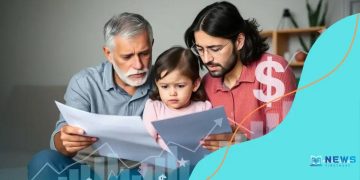Economic forecast: navigating uncertainty in 2024

Eeconomic forecasting involves predicting future economic conditions by analyzing key indicators like GDP, unemployment rates, and inflation, enabling businesses to adapt strategies and mitigate risks effectively.
EconomicForecast offers valuable insights for individuals and businesses alike. As we approach 2024, understanding economic trends becomes essential. Ever wondered how these forecasts might impact your daily decisions? Let’s dive in.
Understanding economic forecasting
Understanding economic forecasting is essential for decision makers and individuals alike. It offers insights into how various market factors influence financial situations and business strategies. Have you ever considered how these forecasts can affect your own financial planning? Let’s explore.
What is Economic Forecasting?
Economic forecasting refers to the process of predicting future economic conditions based on current and past economic data. This involves analyzing various indicators and trends which shape the economy.
Key Indicators
Several key indicators are commonly used in economic forecasting:
- Gross Domestic Product (GDP)
- Unemployment rates
- Inflation rates
- Consumer confidence indices
Understanding these indicators helps in grasping economic trends that could impact your financial future.
Furthermore, economic forecasting can aid businesses in strategic planning. Companies often rely on forecasts to determine potential market demand, optimizing their resource allocation accordingly. For instance, knowing when to ramp up production or when to scale back can be crucial for maintaining profitability.
Types of Economic Forecasting
There are two main types of economic forecasting:
- Qualitative Forecasting: Based on expert judgment and opinions.
- Quantitative Forecasting: Based on numerical data and statistical models.
Utilizing both types can offer a more comprehensive approach, balancing data-driven insights with expert analysis.
Ultimately, understanding economic forecasting empowers individuals and businesses to navigate uncertainties. By staying informed, you can make better decisions that align with future economic conditions.
Key indicators shaping the 2024 forecast
Key indicators shaping the 2024 forecast play a crucial role in understanding the economic landscape. By focusing on these indicators, businesses and individuals can make informed decisions in an uncertain environment.
1. Gross Domestic Product (GDP)
The Gross Domestic Product measures the total value of all goods and services produced within a country. A rising GDP often indicates a healthy economy, while a declining GDP can signal trouble. Watching GDP trends helps prepare for future economic conditions.
2. Employment Rates
Employment rates provide insight into the job market. A low unemployment rate suggests that most people who want to work can find jobs, which typically boosts consumer spending. High employment strengthens the economy.
3. Inflation Rates
Inflation refers to the rate at which prices for goods and services rise. Monitoring inflation rates is important because they affect purchasing power. Low inflation is generally desirable, while high, unstable inflation can hurt the economy.
- Track the Consumer Price Index (CPI) for insights.
- Understand how inflation affects household budgets.
- Evaluate interest rate trends in relation to inflation.
Considering these factors together helps create a panoramic view of economic health.
4. Consumer Confidence
Consumer confidence gauges how optimistic or pessimistic consumers are about the economy. High confidence levels often lead to increased spending, which fuels economic growth. Low confidence can result in reduced consumption.
These indicators often interact with one another. For instance, if employment rates rise, consumer confidence is likely to improve, leading to increased spending and a boost in GDP. By keeping an eye on these key indicators, businesses and individuals can strategize effectively.
Sector analysis: winners and losers

Sector analysis is an important component in understanding which industries are thriving and which are struggling in the current economic landscape. By identifying winners and losers in various sectors, businesses and investors can make more informed decisions.
Identifying Winners
Winners in the economy typically include sectors that show strong growth and resilience in the face of challenges. These sectors are usually responsive to consumer needs and emerging trends.
- Technology: Companies in technology often innovate consistently, leading to sustained growth.
- Healthcare: With an aging population and ongoing health challenges, healthcare remains a strong sector.
- Green Energy: As the world shifts towards sustainable practices, green energy companies are positioned for growth.
These sectors often see increased investments and consumer spending, positioning them advantageously for ongoing success.
Examining Losers
On the flip side, some sectors may struggle due to various factors such as changing consumer preferences or economic downturns. Identifying these losers can be just as crucial.
- Retail: Traditional retail stores face challenges from e-commerce growth.
- Manufacturing: Some manufacturing sectors may decline due to automation and outsourcing.
- Travel and Hospitality: These industries can fluctuate significantly based on public health events and changing travel trends.
Understanding the reasons behind these downturns can provide valuable insights for future planning.
Keeping an eye on both winners and losers ensures that businesses can pivot their strategies as needed. By analyzing sector performance, companies can better align their resources with market opportunities while minimizing risks. This ongoing assessment helps to smoothe out the uncertainties that the economic forecasting may present.
Adapting your business strategy
Adapting your business strategy is essential in a rapidly changing economic environment. With the insights gained from economic forecasts, businesses can make necessary adjustments to stay competitive.
Understanding Market Trends
First, it’s vital to understand the current market trends. Businesses need to stay informed about changes in consumer preferences, technological advancements, and economic conditions. This information helps in shaping a flexible strategy.
Revamping Product Offerings
Revamping product offerings can be a key strategy to adapt effectively. Businesses should analyze which products resonate with customers. They may choose to:
- Expand: Introduce new products that meet emerging needs.
- Improve: Enhance existing products based on customer feedback.
- Discontinue: Phase out underperforming items to focus resources on successful ones.
Having the right products can make a significant difference in sales and customer satisfaction.
Emphasizing Agility
Another critical aspect is to emphasize agility within the organization. Companies that can quickly adapt to changes tend to be more successful. Implementing agile practices allows teams to respond quickly to market demands, customer feedback, and economic shifts. Small adjustments can lead to big impacts.
Investing in employee training and development also ensures that staff are equipped with the necessary skills to adapt. A well-prepared workforce contributes to overall business resilience and innovation.
Utilizing Data for Decision Making
Utilizing data effectively is paramount. By analyzing sales data, customer behavior, and market trends, businesses can make informed decisions that lead to strategic adjustments. Data-driven decisions can reduce the risks associated with changes.
Ultimately, adapting your business strategy is about aligning with the current economic landscape. By analyzing key indicators and trends, a business can develop a roadmap for growth and sustainability.
Preparing for potential challenges
Preparing for potential challenges is crucial for businesses aiming to thrive in uncertain times. By anticipating issues, companies can develop strategies to mitigate risks and maintain stability.
Identifying Potential Risks
One of the first steps is to identify potential risks that may arise. This includes:
- Market Changes: Sudden shifts in market conditions can affect demand.
- Regulatory Changes: New laws or regulations may impact operations.
- Supply Chain Disruptions: Delays in the supply chain can hinder product availability.
By recognizing these risks early, businesses can craft proactive plans.
Developing Contingency Plans
Once potential risks are identified, it’s essential to develop contingency plans. These plans outline specific actions to take in response to challenges. For example, if a supply chain issue arises, having multiple suppliers can help maintain steady production. Regularly reviewing and updating these plans ensures they remain effective and relevant.
Investing in Technology
Investing in technology can also be beneficial for preparing for challenges. Advanced software can help monitor market trends and manage supply chain logistics more effectively. Businesses that leverage data analytics can gain insights that inform their strategies.
Training employees to use new technologies fosters adaptability and improves overall productivity. When employees are prepared to handle various situations, the organization becomes more resilient.
Staying Informed
Additionally, staying informed about industry trends and economic forecasts is vital. Regularly reviewing economic projections allows businesses to anticipate challenges better. Networking with industry peers can also provide valuable insights into how other organizations are navigating potential pitfalls.
Ultimately, by preparing for potential challenges, businesses can position themselves for success, regardless of the economic climate. This proactive approach not only safeguards against risks but also enables growth and innovation.
In conclusion, navigating the complexities of economic forecasting and sector analysis requires proactive planning and adaptability. By understanding key indicators and preparing for potential challenges, businesses can position themselves for success. Embracing change and leveraging data will help organizations remain resilient in a fast-evolving market. Remember, staying informed and agile is crucial to thriving in any economic environment!
FAQ – Frequently Asked Questions about Economic Forecasting and Business Strategy
What are key indicators in economic forecasting?
Key indicators include GDP, unemployment rates, inflation rates, and consumer confidence, which help predict future economic conditions.
How can I prepare my business for potential challenges?
You can prepare by identifying risks, developing contingency plans, investing in technology, and staying informed about market trends.
Why is sector analysis important?
Sector analysis helps businesses identify winners and losers in the economy, enabling them to adapt strategies and allocate resources effectively.
How does data analytics improve decision-making?
Data analytics provides insights into customer behavior and market trends, allowing businesses to make informed decisions that align with their goals.





